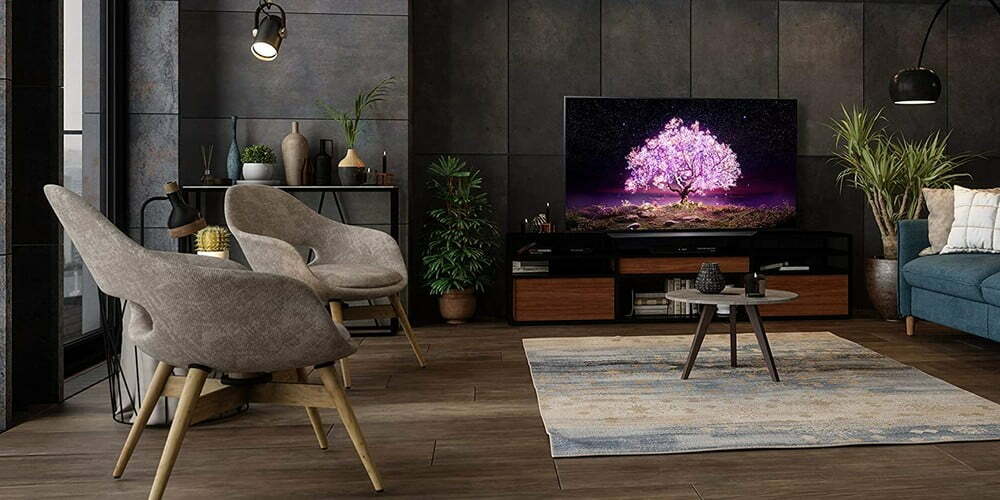Television brands constantly improve their TVs each year. To do this, they may introduce new technology, such as quantum dots or organic light-emitting diodes (OLEDs.) One of the most recent introductions, NanoCells, shapes the future for LG and will probably be among the best TVs in the market. This new technology may leave people wondering what is NanoCell TV.
KEY TAKEAWAYS:
- LG exclusively manufactures NanoCell TVs.
- NanoCell TVs feature the same technology as LED TVs with an additional filter containing NanoCells.
- The added NanoCell filter enhances contrast and colors on the TV.
What Exactly is a NanoCell TV?
NanoCell TVs work the same as light-emitting diode (LED) liquid crystal display (LCD) models, but they have an additional filter layer. LCD TVs house many liquid crystals arranged in a grid, with three color filters, one each of red, green, and blue. These crystals do not produce the light necessary for the display, so each TV includes a backlight system. You should know what is LCD TV and if your TV model has this type of display. In most cases, this backlight system is one with LEDs. There are several arrangements of LED panels.
NanoCell TVs have a film layer that contains NanoCells. This layer aims to increase brightness and color contrast while also reducing light bleeding into the darker surrounding areas. They are much better than plasma TVs if you know what a plasma TV is. Additionally, NanoCells may help to create a more immersive experience.
Pure Colors on NanoCell TVs
One of the NanoCell filter functions comes from the belief that colors bleed into one another on a TV screen. This concept can be seen in various optical illusions, where the eye sees the same color differently depending on the surroundings. However, TVs may show vibrant and authentic colors with the filter, allowing viewers to observe the content as the creator intended. With this filter, consumers notice that the colors on the screen have better contrast between colors and brighter whites and deeper darks.
Additionally, LG aims to present more precise colors, meaning that the color shows in the areas it is needed and not others. With regular TVs, consumers may notice the effect of colors bleeding together. This effect is separate from the impure colors mentioned above because the colors actively affect the surrounding pixels. To combat this effect, LG has begun introducing mini-LEDs and full array dimming. Each of these technologies exists with the express intent of reducing the bleed-through of other colors where darkness should be.
Increased Viewing Angles on NanoCell TVs
In many models, NanoCell TV may also allow for wider viewing angles. Because the colors are more precise and only where they should be, the viewing angle should affect the detail and clarity of the image less. This idea means that viewers can sit in a wider variety of positions and see a similar image. In the future, LG may combine quantum dot and NanoCell technology together to create QNED TVs. Quantum dot filers are used in quantum dot light-emitting diode (QLED) TVs to a similar effect to that of a NanoCell television.
NanoCell TVs typically include 4K or 8K resolutions. You likely already know that 8K resolution is four times better than 4K. 8K resolution jams even more tiny pixels into your screen, making for a sharper and more realistic image, offering 33 million pixels (7680X4320.) Every aspect of NanoCell TVs also aims to produce a more immersive viewing experience.
F.A.Q.
Are NanoCell TVs good?
NanoCell TVs are intended to produce more vibrant and precise colors and clarity.
Is LG NanoCell good for PS5?
One aspect of many NanoCell TVs, TruMotion, attempts to reduce the blur between images’ frames. Because of this and the fact that many NanoCell TVs feature 4K or 8K resolution, gamers may notice the PS5 enhanced graphics more.
What is the life of an OLED TV on average usage?
An OLED TV at 100% brightness should have a lifespan of around 10,000 hours.
STAT: For example, you likely already know that 8K resolution is four times better than 4K. 8K resolution jams even more tiny pixels into your screen making for a sharper and more realistic image, offering 33 million pixels (7680X4320). (source)

































![Best Drones Under the Cost of Ferrari in [year] 25 Best Drones Under the Cost of Ferrari in 2025](https://www.gadgetreview.dev/wp-content/uploads/image-test-3.jpg)
![Best LEDs & LCDs in [year] ([month] Reviews) 26 Best LEDs & LCDs in 2025 (November Reviews)](https://www.gadgetreview.dev/wp-content/uploads/Samsung-UN65RU7100FXZA.jpg)
![Best Streaming Services in [year] ([month] Reviews) 27 Best Streaming Services in 2025 (November Reviews)](https://www.gadgetreview.dev/wp-content/uploads/netflix-750x422-1.png)
![Best Streaming Movie and Shows in [year] ([month] Reviews) 28 Best Streaming Movie and Shows in 2025 (November Reviews)](https://www.gadgetreview.dev/wp-content/uploads/Streaming-reviews.jpg)
![Best TVs in [year] ([month] Reviews) 29 Best TVs in 2025 (November Reviews)](https://www.gadgetreview.dev/wp-content/uploads/Sony-XBR55X810C-TV-1.jpg)
![Best Shows on Amazon in [year] ([month] Reviews) 30 Best Shows on Amazon in 2025 (November Reviews)](https://www.gadgetreview.dev/wp-content/uploads/The-Boys-750x474-1.jpg)
![Best Small TVs in [year] 31 Best Small TVs in 2025](https://www.gadgetreview.dev/wp-content/uploads/best-small-tv-image.jpg)
![Best 60 Inch TVs in [year] 32 Best 60 Inch TVs in 2025](https://www.gadgetreview.dev/wp-content/uploads/best-60-inch-tv-image.jpg)
![Best 50 Inch TVs in [year] 33 Best 50 Inch TVs in 2025](https://www.gadgetreview.dev/wp-content/uploads/best-50-inch-tv-imgr.jpg)
![Most Energy Efficient TVs in [year] 34 Most Energy Efficient TVs in 2025](https://www.gadgetreview.dev/wp-content/uploads/most-energy-efficient-tv-image.jpg)
![Best TVs for Apple TV in [year] 35 Best TVs for Apple TV in 2025](https://www.gadgetreview.dev/wp-content/uploads/best-tv-for-apple-tv-image.jpg)
![Best TV Antennas in [year] ([month] Reviews) 36 Best TV Antennas in 2025 (November Reviews)](https://www.gadgetreview.dev/wp-content/uploads/best-tv-antennas-image.jpg)
![Best Mitsubishi TVs in [year] 37 Best Mitsubishi TVs in 2025](https://www.gadgetreview.dev/wp-content/uploads/best-mitsubishi-tv-image.jpg)
![Best Smart TVs in [year] ([month] Reviews) 38 Best Smart TVs in 2025 (November Reviews)](https://www.gadgetreview.dev/wp-content/uploads/best-smart-tvs-image.jpg)
![Best Conference Room TVs in [year] 39 Best Conference Room TVs in 2025](https://www.gadgetreview.dev/wp-content/uploads/best-conference-room-tv-image.jpg)
![Best Dumb TVs in [year] 40 Best Dumb TVs in 2025](https://www.gadgetreview.dev/wp-content/uploads/best-dumb-tv-image.jpg)
![Best 80 inch TVs in [year] 41 Best 80 inch TVs in 2025](https://www.gadgetreview.dev/wp-content/uploads/best-80-inch-tv-image.jpg)
![Best Shows on Hulu in [year] ([month] Reviews) 42 Best Shows on Hulu in 2025 (November Reviews)](https://www.gadgetreview.dev/wp-content/uploads/The-Handmaids-Tale-750x422-1.jpg)

















